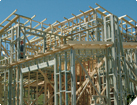Material Use
Specifying efficient use of materials and considering their impact from manufacture to disposal.
Construction systems
Construction systems are the ways in which materials are combined to construct the elements of a building. They can be classified according to the mass of the system into heavyweight and lightweight construction.
For example, New Zealand houses typically use lightweight construction systems comprising timber framing combined with building underlay, insulation and internal and external cladding materials for the walls and roofs.
Heavyweight construction generally uses reinforced concrete, concrete masonry or brick.
On this page:
- heavyweight construction
- lightweight construction
- which construction system to use.
Heavyweight construction
Characteristics of heavyweight construction include:
- excellent durability
- low maintenance
- potential for thermal mass (with appropriate design)
- most suited to climates with a large diurnal (day/night) temperature range
- should not be used on remote sites where materials must be transported for long distances
- generally higher embodied energy and a bigger carbon footprint
- generally significant site impact and disturbance because of substantial foundation system requirements
- generally quarried raw materials that cause a high impact on the landscape
- generally require heavy lifting equipment on site
- often require temporary support during construction, which can increase waste.
Lightweight construction
Characteristics of lightweight construction include:
- less durable than heavyweight construction
- higher maintenance required than heavyweight construction
- greater responsiveness to outdoor temperature changes – this can be beneficial by cooling more rapidly at night in warmer climates
- suitable for remote sites where materials must be transported for long distances
- generally lower embodied energy and a smaller carbon footprint
- generally lower site impact and disturbance than heavyweight construction
- generally lower environmental impact, for example, sustainably sourced timber, sometimes kiln-dried using biomass fuel
- able to be handled without the need for heavy machinery.
Which construction system to use
The type of construction system used for a project can affect the building’s:
- sustainability
- thermal performance
- environmental impact/carbon footprint.
Which construction system is selected for a building depends on the:
- local availability of materials and skills
- durability of the material
- intended lifespan of the system/building
- maintenance requirements
- life cycle costs and energy consumption
- environmental impact
- end use/reuse potential.
Generally, there is no one best solution, but a number of options depending on a range of factors.
Updated: 09 March 2023


